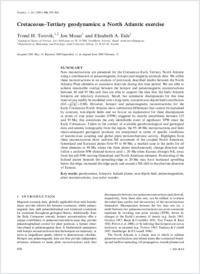Cretaceous-Tertiary geodynamics: a North Atlantic exercise
- Torsvik, Trond H. Geological Survey of Norway, Trondheim, Norway - Department of Mineralogy and Petrology, Lund University, Sweden
- Mosar, Jon Department of Geosciences, University of Fribourg, Switzerland
- Eide, Elizabeth A. Geological Survey of Norway, Trondheim, Norway
-
20.12.2001
Published in:
- Geophysical Journal International. - 2001, vol. 146, no. 3, p. 850-866
English
New reconstructions are presented for the Cretaceous–Early Tertiary North Atlantic using a combination of palaeomagnetic, hotspot and magnetic anomaly data. We utilize these reconstructions in an analysis of previously described misfits between the North Atlantic Plate elements at successive intervals during this time period. We are able to achieve reasonable overlap between the hotspot and palaeomagnetic reconstructions between 40 and 95 Ma and thus are able to support the idea that the Indo–Atlantic hotspots are relatively stationary. Small, but systematic discrepancies for this time interval can readily be modelled with a long-term, octopole non-dipole field contribution (G3 = g₃⁰/g₁⁰ = 0.08). However, hotspot and palaeomagnetic reconstructions for the Early Cretaceous North Atlantic show substantial differences that cannot be explained by constant, non-dipole fields and we favour an explanation for these discrepancies in terms of true polar wander (TPW) triggered by mantle instabilities between 125 and 95 Ma; this constitutes the only identifiable event of significant TPW since the Early Cretaceous. Taken in the context of available geochronological and geological data and seismic tomography from the region, the 95–40 Ma reconstructions and their time-consequent geological products are interpreted in terms of specific conditions of mantle-crust coupling and global plate motions/tectonic activity. Highlights from these reconstructions show uniform NE movement of the coupled North American, Greenland and Eurasian plates from 95 to 80 Ma; a marked cusp in the paths for all three elements at 80 Ma where the three plates simultaneously change direction and follow a uniform NW-directed motion until c. 20 Ma when Eurasia diverges NE, away from the still-NW-moving Greenland and North American elements. Positioning of the Iceland plume beneath the spreading-ridge at 20 Ma may have increased upwelling below the ridge, increased the ridge-push, and caused a NE shift in the absolute direction of Eurasia.
- Faculty
- Faculté des sciences et de médecine
- Department
- Département de Géosciences
- Language
-
- English
- Classification
- Geology
- License
- License undefined
- Identifiers
-
- RERO DOC 4930
- DOI 10.1046/j.0956-540x.2001.01511.x
- Persistent URL
- https://folia.unifr.ch/unifr/documents/299608
Statistics
Document views: 108
File downloads:
- 1_mosar_ctg.pdf: 395
